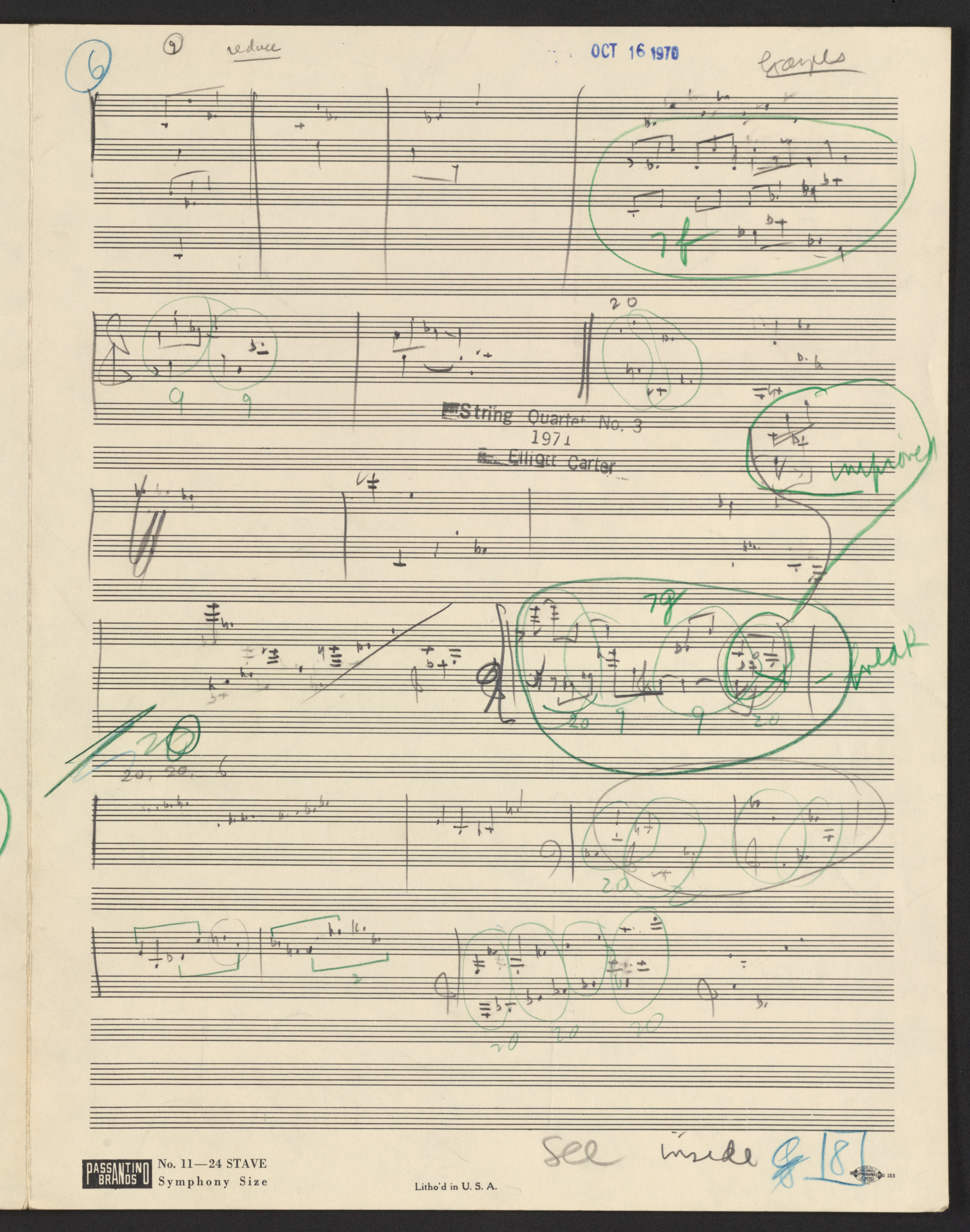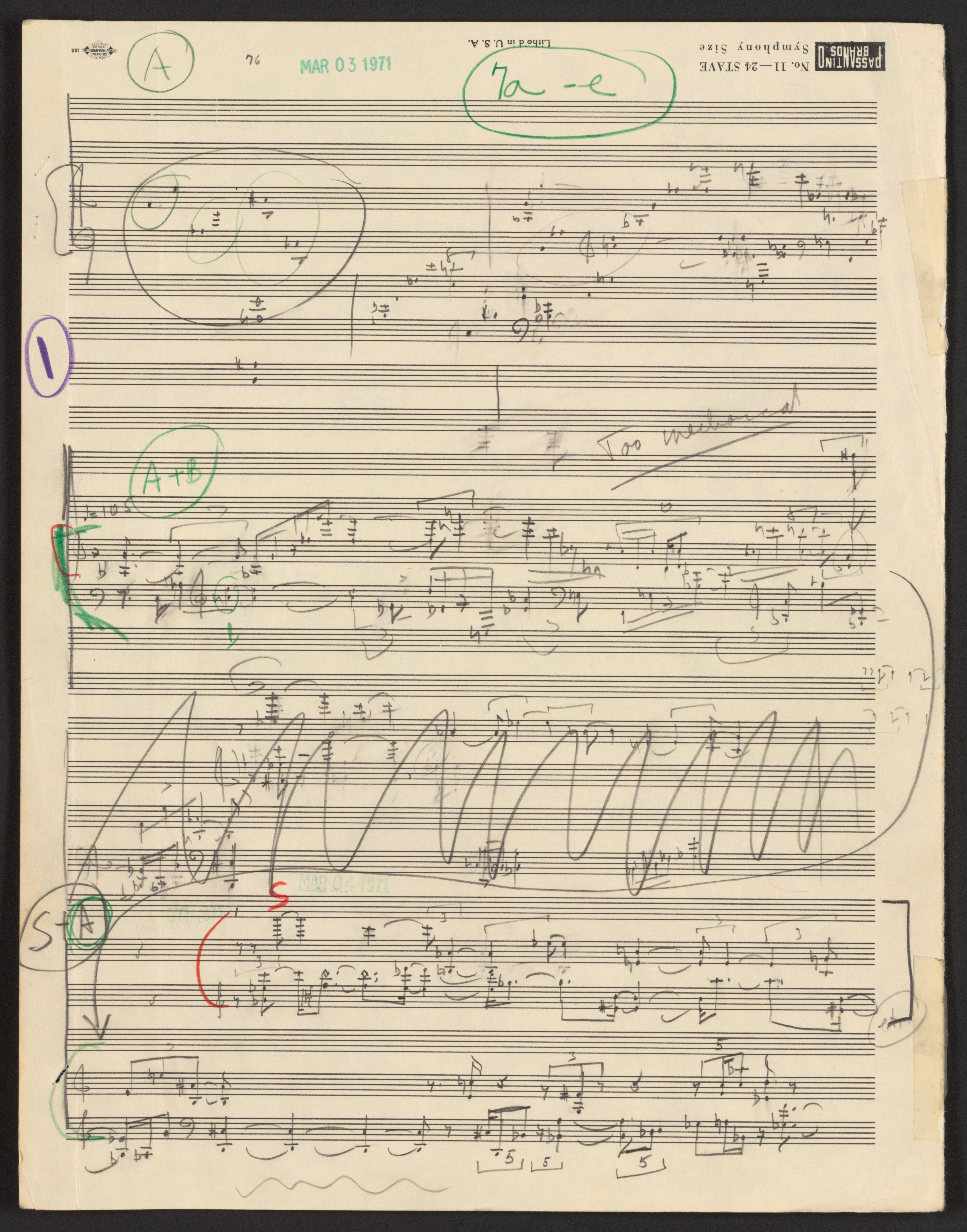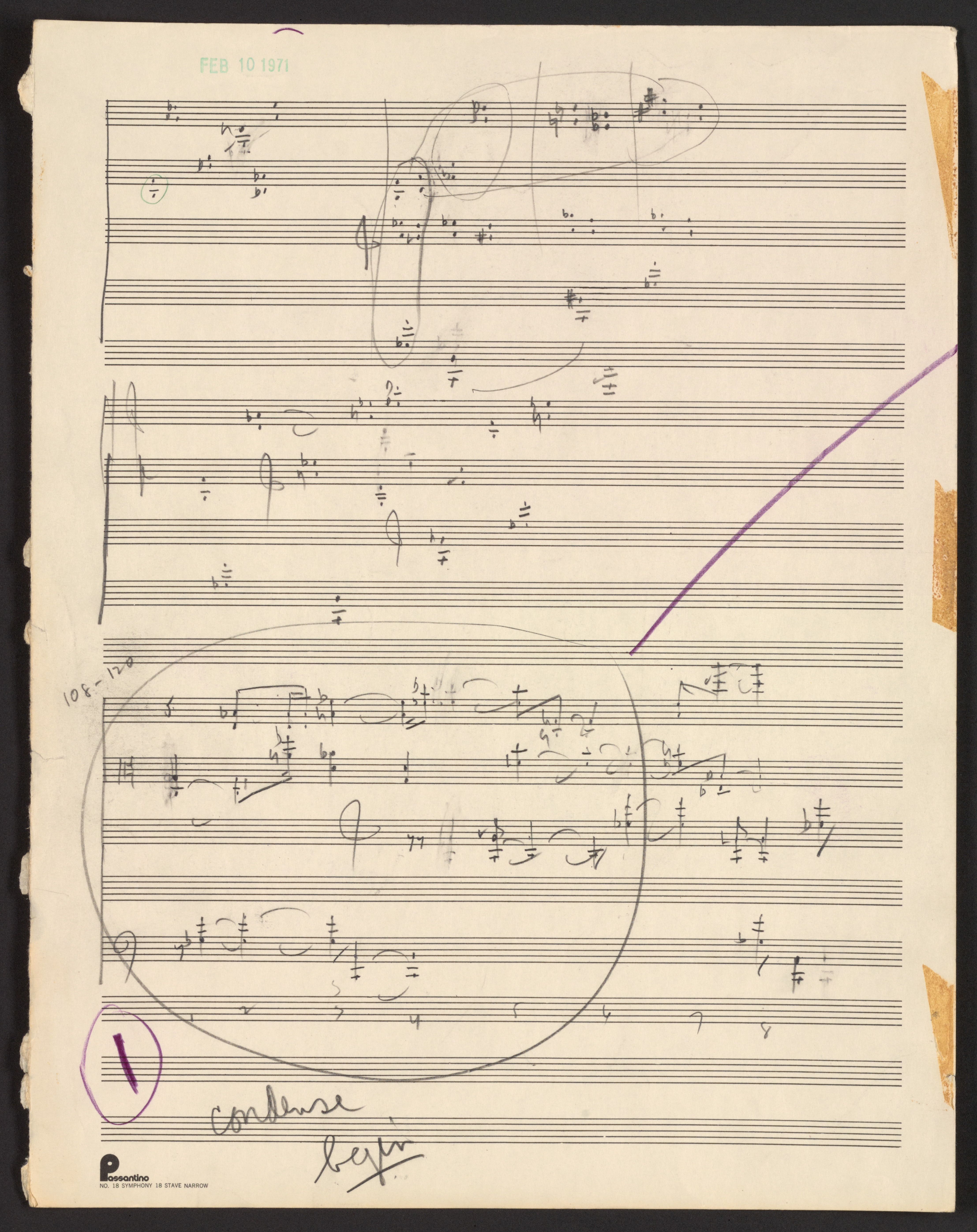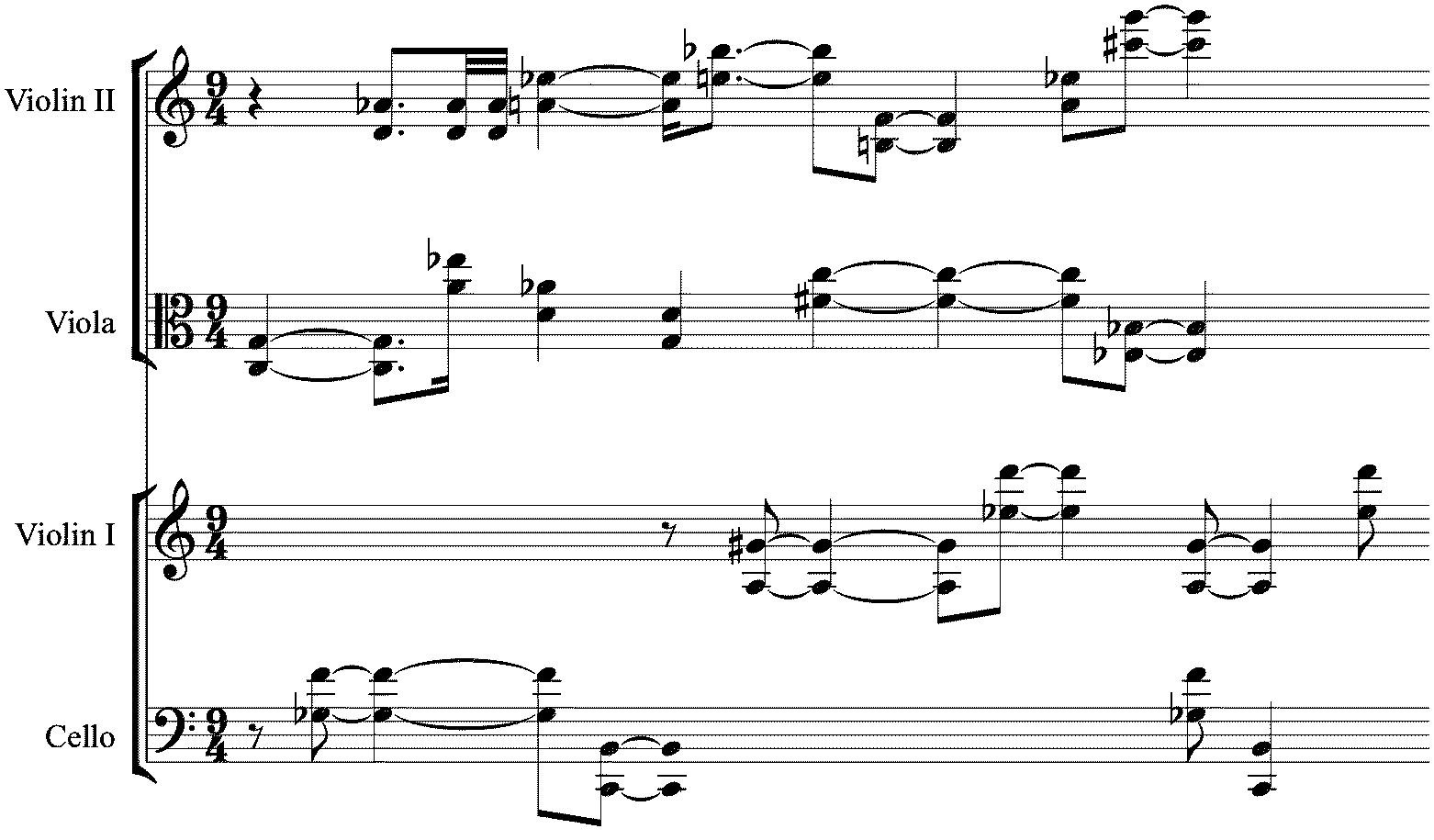Guilty Pleasures: A Quick Glimpse Inside a Composer’s Workshop
Andrew W. Mead
[ 1 ] When I was asked by the editors to consider writing a commentary on a page or two of Elliott Carter’s sketches for his String Quartet No. 3, I wrote back that I was happy to do so. But that immediately led me to think about what it actually is I am doing when looking at a composer’s sketches. In general, I think I feel a bit uneasy looking at sketches. It can feel a bit voyeuristic, as though I’m looking over someone’s shoulder while they are doing private work. Brahms quite famously stripped old manuscripts off the wall of an apartment where he had pasted them to block out cold drafts. On the other hand, I am grateful to have seen facsimiles of what Mahler left of his 10th symphony and to have heard the realizations of incomplete works by the likes of Schubert, Bruckner and Elgar, all based on various scholars’ careful perusal of those composers’ sketches. In the case of Elliott Carter, the composer was gracious enough to preserve his sketches and to donate them to institutions that would make them available – a true glimpse into a composer’s workshop.
[ 2 ] While this allays my initial qualms about looking at sketches, I find I still have some questions about the activity, at least for myself. The analysis of a piece is itself performative, the result of the receiver of the music trying to articulate for him or herself, and others, the experience of listening to recordings and live performances, assisted by score study. This can be aided by studying a composer’s sketches, but the analyst must be careful to consider to what degree insights so gained might hold sway. After all, analysis is much more than trying to reverse-engineer what a composer has done in making a piece; and trying to argue from authority, be it from sketches or from statements made by the creator, is fraught with problems.
[ 3 ] Nor is looking for confirmation of one’s own ideas particularly useful. I was asked some years ago by a friend if I cared whether Carter thought about his music the same way I did. I replied that if I did care, I was putting myself in the position of having to hinge my love of his music on whether or not his take matched my notions about it. I cared far more for the music and the pleasure it gave me than for any ideas I might have had about it. And that continues to this day.
[ 4 ] Sketch studies can certainly be useful for answering the “what did the composer know, and when did they know it” kinds of questions that arise when thinking about densely structured music. Watching Schoenberg figuring out hexachordal inversional combinatoriality or working out a cross-referential partition scheme can be fascinating, but, of course, compositions aren’t just demonstrations of technical schemes. Alterations of notes or rhythms predicted by a presumed methodology arise all the time in all sorts of music where a composer is responding to some musical imperative that overrides the demands of whatever system he or she is working within. This is certainly true for Carter. The long-range triple polyrhythm of the Triple Duo does not play out as one might expect, but that in no way diminishes the impact either of the piece on a listener, or of the contributions that polyrhythm makes to its flow.
[ 5 ] Beyond all of these caveats is the problem of choosing what to look at, given the mountain of pages Carter left for every piece. There are just shy of 1,900 pages of sketches for the String Quartet No. 3, and a proper study would have the potential of yielding a document more suitable for a book manuscript than for a brief commentary like this one. Scrolling through the Library of Congress’s magnificent digitized display is both a treat and a daunting task – a treat because one can glean all sorts of interesting insights both into Carter’s working methods and his occasional commentary to himself but daunting due to the sheer size of the material. Having looked at 700 pages, is it possible that the remaining 1,200 might contain the Rosetta Stone? And further, what might be gleaned from a thorough study of Carter’s use of different colors, numbers and shapes? Does, for instance, the number 20, found next to circles around several tetrachords made of dyads on page 254, refer to his own system of labeling collection types? (See Example 1.)
Example 1
Elliott Carter, String Quartet No. 3, sketch 254
Elliott Carter Collection, Library of Congress, Washington D.C.

Indeed, all of the circled tetrachords are members of the same collection class, but looking back at a much earlier page in the sketches (and one dating from several years earlier), a page that would seem to be a catalogue of tetrachord types designates this particular type as 19. Am I making a mistake? Did Carter make a mistake? Or does the number 20 refer to a different group of objects altogether? And does it really matter? These are the questions that cross my mind as I enter what feels like an enormous attic, one filled with a huge variety of information unfolded in a way that sometimes seems orderly but other times seems almost random. Again, I confess this is my reaction and no reflection on the curators of this remarkable collection.
[ 6 ] Before closing in on one or two particular pages, I want to mention two features that leap out from a partial perusal of these sketches. In what must be pages from quite late in Carter’s process, one finds pretty much the whole quartet written out in notes and rhythms in considerable detail. Pages from a later pass provide an overlay in red of dynamics, phrasing slurs and articulation marks. This is reminiscent of Max Reger’s practice of drafting a piece and subsequently editing it in red to refine the details of performance. It would be interesting to pursue further the place of such indications in Carter’s compositional practice; it would seem to suggest an intense awareness of the process of playing his music in shaping his decisions. I find this a compelling link between Carter’s musical thinking and the music of the past, in which the notes and rhythms are of greater moment in constructing a score, while the degree to which a notation indicates to the player just how to shape a passage is considered not secondary, but a more fluid issue, shaped by traditions of performance practice. Compare this with the practice of a composer like Pierre Boulez, or Milton Babbitt, in which dynamics, for instance, are either determined by some sort of systematic patterning, or are themselves a means by which to articulate a counterpoint of rhythmic lines.
[ 7 ] Another form of detail that appears occasionally is Carter’s comments to himself. Page 284, for example, contains the remark “too mechanical” which reinforces for me the sense I’ve always had about Carter’s music, that all of the rhythmic and pitch structures are at the service of larger expressive aims (see Example 2). Despite the extensive working out of both pitch and rhythmic patterns, this music isn’t simply the demonstration of theoretical ideas.
Example 2
Elliott Carter, String Quartet No. 3, sketch 284
Elliott Carter Collection, Library of Congress, Washington D.C.

[ 8 ] Now, to two actual pages drawn from the sketches, and what will be admittedly sketchy remarks of my own. The first page I want to comment on is sketch no. 299, which appears to be a first stab at the opening of the piece (see Example 3).
Example 3
Elliott Carter, String Quartet No. 3, sketch 299
Elliott Carter Collection, Library of Congress, Washington D.C.

There is a date stamp, February 10, 1971, at the top, then two systems of unstemmed dyads, and at the bottom, a system with a bit more rhythmic detail. This is circled, with a circled number 1 in purple next to it, plus the penciled in remark “condense begin” (perhaps short for beginning). A purple line would seem to connect to another page, but what page that might be is not immediately evident in the surrounding pages of sketches. The first two systems on this page would seem to be initial attempts to assemble dyads; fifths and tritones in the upper two staves, and Major sevenths in the lower two. Clefs are not all that in evidence in the uppermost system, but it is clear that the two upper systems are a kind of working out of the music that is circled in the lowest part of the page. And something we can observe even here is that Carter’s unusual instrumental layout of the score, with 2nd violin paired with viola in the upper two staves and 1st violin and cello in the lower two staves, is already implicit in this sketch. In fact, when we compare the bottommost sketch with the opening of the finished score (see Examples 4a and 4b), we can make out that the dyads in the lower duo are present, while the types of the dyads, plus the kinds of collections formed between instruments in the upper staves, are present in a more vigorous realization in the actual score. Carter’s note to himself would seem to have directed him into this ultimate revision.
Example 4a
Elliott Carter, String Quartet No. 3, sketch 299 (detail), transcription

Example 4b
Elliott Carter, String Quartet No. 3, opening
Copyright © 1973, 1998 by Associated Music Publishers, Inc. (BMI) New York, NY

[ 9 ] Of interest is what is preserved, and what kind of changes Carter has allowed himself. The gesture in the lower duo may have been intensified, but the notes remain unchanged through the sketches to the final draft. The sonorities of the upper duo are a constant, but that sound of the open C and G strings in the viola, present throughout the sketch, has been altered. It’s interesting to note, however, that as he refines how he wants the opening to unfold in the second system of the sketch, Carter adds the dyad D, A♭ in the upper duo’s violin to the viola’s C, G. This tetrachord is of the same type as the one found in the final score, transposed to the notes F♯, C in the viola, and B♭, F in the violin. The transposed version maintains the intervallic structure of the opening, but makes a deeper connection to one of the significant large-scale aspects of the quartet. In this piece, Carter uses a particular ordering of the twelve pitch-classes, articulated in register. One of the four-note segments of this chord is F, G♭, B♭, C, the notes found in the upper duo’s instruments at the very outset of the piece, albeit in a different register. But the particular notes, dyads and collections projected by this chord have an impact throughout the piece, both in their original registers and as pitch-class collections.(1)Andrew W. Mead, “Pitch Structure in Elliott Carter’s String Quartet #3,” Perspectives of New Music 22, no. 1: 31-60. Here is not the place to detail this aspect of the quartet, but one more sketch is, I think, worth noting, as it contains what might be the seeds for further analytical study.
[ 10 ] Sketch 287 might seem hardly worth noticing; it’s mostly a blank page, with two arpeggiated chords over the beginnings of two staves at the very top (see Example 5).
Example 5
Elliott Carter, String Quartet No. 3, sketch 287 (detail)
Elliott Carter Collection, Library of Congress, Washington D.C.

My Example 6 transcribes these two chords, adding a couple of what I posit as missing notes, as well as suggesting a note miswritten, or perhaps not clearly legible. The first of these two chords is, in fact, the twelve-note chord familiar from the quartet (missing its two top notes, E♭7 and A♭7; see Example 6).
Example 6
Elliott Carter, String Quartet No. 3, twelve-note chords

The other chord, however, reverses the order of the intervals of the first (with E♭ and A♭ included), starting and ending on the same notes, D and A♭/G♯. (Given that this is in effect an all-interval 12-tone row, the boundary interval is inevitably a tritone.) If we consider these two chords as 12-tone rows, they would be related by retrograde inversion, which is why the pattern of intervals is reversed from top to bottom.
[ 11 ] To me, two things stand out. First, this suggests that using the tools of twelve-tone analysis for dealing with certain aspects of Carter’s music is not too far from some of the basic concepts Carter is working out here. But much more interesting to me is that this transformation seems highly suggestive with regards to thinking about extensions to some of the concepts already explored in this piece. As has been pointed out, the ordered dyads formed by the 12-note chord, both in the registers determined by the chord, segmentally and in various compounds, play an important role in the quartet. What I am noticing here is possible evidence that the dyads formed by the RI version of the chord might similarly have received a kind of prominence in the piece. This is purely speculative on my part at the moment, but I hope it suggests how a look at the sketches of this piece might induce a revision or extension of some initial ideas.
[ 12 ] I’ll admit I’m a bit skeptical of this last speculation, as it would need both analytical work to flesh it out, and some close self-scrutiny to see whether or not this is me projecting my own desires and ideas onto the music. As I suggested at the outset, I am leery of what sketch studies can lead me to consider, but if done with a certain amount of care and humility, they might in fact provide some insights into this remarkable body of music.
Footnote
1. Andrew W. Mead, “Pitch Structure in Elliott Carter’s String Quartet #3,” Perspectives of New Music 22, no. 1: 31-60